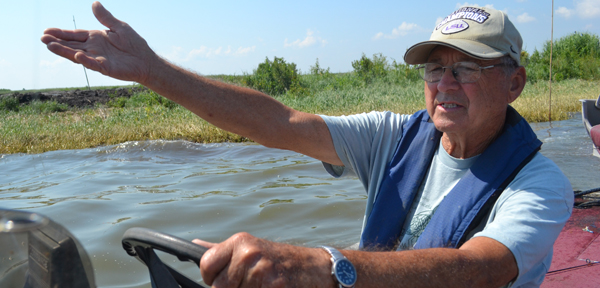
Was honored by president for his work
It was a mild summer day in August as Milton Cambre piloted his fishing boat down the Spillway Canal and toward Lake Pontchartrain.
Since he was 27 years old, Cambre has dedicated a large amount of his life to the preservation and restoration of St. Charles Parish’s coastal waters that abut Lake Pontchartrain in Norco.
Over that time, the now 78-year-old Cambre has successfully led a protest against the construction of a levee on the coast, witnessed large amounts of land loss, assisted in reclamation efforts, helped in the building of Wetland Watchers Park and received awards, most notably from President George H. W. Bush, as well as many others.
Cambre has been chairman of the Coastal Zone Advisory Committee (CZA) for the past 35 years, an unpaid position, during which time he has also been District 6 Constable. He recently announced that he will step down from both positions.
“I am not a bureaucrat, I am just a little guy trying to get something positive done so we can preserve what we have for future generations,” he said.
On the way out of the Spillway area, Cambre made a hard left into another canal and his boat passed by numerous bobbers signaling crab traps beneath the surface.
Cambre said he started seeing the effects of erosion in the Labranche Wetlands shortly after moving to Norco in the early 1960s.
“I use to crawfish out here,” he said. “I’d come out here every year and catch a whole load of crawfish and then one year I caught a crab and I thought it was strange. I kept catching more and more crabs every year because more saltwater was coming into the area.”
Crossing underneath the railroad and then the eastbound lane of I-10, Cambre idled the boat in the open space between the two looming spans of the interstate overhead.
“This used to be cypress swamp all through here. When they built the I-10 canals they just came in and clear cut all of it. You can see some of the stumps sticking out of the water still,” he said. “That’s really what started it all. They had absolutely no thought of what would happen when they came in here and did this. It just devastated the environment.”
Cambre pointed out to the open lake.
“The shoreline until that time was about 1,000 feet further out,” he said. “All that got washed away.”
Since then, Cambre has increased efforts to maintain what shoreline is left and to keep it from coming in any further. Through his efforts he has helped place a rock berm around 13,000 feet of shoreline. Recently another 3,000-foot rock berm was added to the area around Wetland Watchers Park, but Cambre said the area still has a long way to go.
“We have roughly 16,000 feet done and what we need is roughly another 15,000 and we are halfway there,” he said. “But the cost has dramatically increased.”
When the first berm was put in place 25 years ago, Cambre said it cost $1 million per mile, a cost that has now gone up to $1 million per 1,000 feet.
“That goes to show how delays make it more costly,” he said. However, Cambre had a larger goal on his mind. “I need to get somebody to take my place,” he said.
Throughout his time as first president of the St. Charles Coastal Council and now as chairman of the CZA, the results have been a mixed bag. Now that he is preparing to retire, he is worried about the future.
“When I started doing this I honestly didn’t know I would be doing it this long,” he said. “I look out here and I can see the difference we’ve made, but the federal government has a tendency just to steamroll over everything in its way and do whatever it wants to do even though we are the ones who have to live with the results.”
Cambre said that the federal and state entities that have come to govern the coastal waters of St. Charles Parish have not been as reactive to the local community as he would like.
He unrolls a small surveying photograph of the area and points to a dam that is out in the lake.
“Right here they just tried to dam up the canal after they were done with it, but instead of putting the dam to the back they put it way out front,” he said. “That washed out after about two years and didn’t do anything.”
Cambre brings up several other projects that were not thought out, such as Hammond Highway. The highway was constructed along the Lake Pontchartrain shoreline in the early 30s, but flooded before it could be used. He also mentions the Mississippi River Gulf Outlet Canal.
“The Mr. Go (Mississippi River Gulf Outlet Canal) was awful for the environment. They said it was going to create all of these jobs when they built it, but only a few years after construction was complete most of the boats could not pass through it because it was too shallow,” he said.
That project would cost around $8 million per year to maintain and only served two ships per day before it was named as a culprit in coastal erosion. It also served as a channel for coastal waters to infiltrate New Orleans during Hurricane Katrina. In 2009, the canal was closed off for good after 50 years of service.
Cambre said there have been plenty of other projects done for the sake of economic interest that didn’t help the economy and ended up further damaging coastal areas in the process.
“I’ve been accused of being anti-job,” he said. “I’m not anti-job. I just want the bureaucrats to think a little more before they come and do something that they can’t undo and we have to live with the after effects. Let’s do something, but let’s be smart about what we are doing.”
The latest project Cambre is concerned about is a state and federal project that is focused on reclaiming areas around the Wetland Watchers Park that have experienced massive erosion over the past decades.
He pulls his boat alongside the mounds of dirt that have been piled along the coast. It is a large body of water that is separated from the lake by only a sliver of shoreline. Cambre points on his map to a mass of land directly to the west that is entirely filled in.
“This area used to be just like this one,” he said. “We came in here with fill and when we first did it we didn’t put up a rock berm. Within six months it was all washed away – just like we had never done anything,” he said. “Now 25 years later they are doing the same thing here. They are spending $10 million on this project without putting a rock berm in first. Once a big storm comes in here all of that dirt is going to get washed out just like what happened to us. We’ve been trying to tell them this, but it takes a while.”
Though Cambre was able to accomplish much through the years, he wants to be remembered for bringing attention and raising awareness about coastal restoration.
“I want people to understand that this is part of our culture and this is part of our way of life,” he said.
Harry Hurst teacher Barry Guillot, himself a staunch advocate of coastal restoration, said Cambre is his hero.
“Mr. Milton is a personal hero of mine and I know that he has inspired so many people through his efforts,” he said. “His knowledge goes beyond the scientific research. His entire recreational life has been spent fishing these areas. He knows the winds, the tides and all of the natural tendencies of the area.
“Even though he may not officially be at the meetings, I am sure that he will always be available if his opinion is needed.”
With 51 years serving the parish and its coast, Cambre said although he will be stepping away from a leadership position he will likely still provide material support.
“I’ve already notified that I am gong to back away. I am going to be one of the guys in the background. I am not saying I am going to completely back away from it, but I am not going to be involved in the day-to-day operations,” he said.
After all, Cambre said the coast still needs so much work that he cannot stop altogether.
“There is still so much left to be done,” he said. “There is a need for people to watch out and make sure that things are done in an environmental manner that will both preserve and protect what we have and also at the same time do what it is they are desired to do.”




Be the first to comment